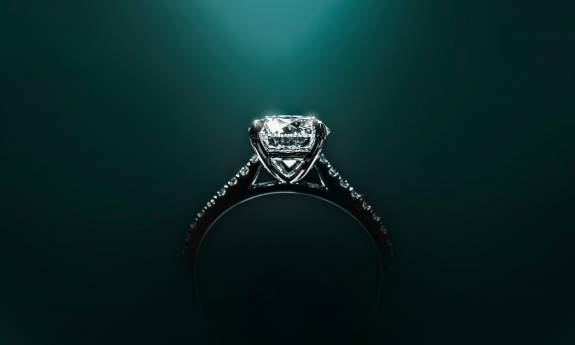
Lab Grown Diamonds
Affordable, sustainable & fair.
Lab Grown Diamond - What is it?
A different Path
Laboratory Grown Diamonds are diamonds created in a laboratory, rather than in nature. A technical masterpiece of mankind.
Laboratory Grown Diamonds are genuine diamonds. They have the same crystal structure and are identical in their chemical, physical and optical structure to diamonds created in nature.
Diamonds are carbon atoms arranged in a cubic structure.
Because the formation of Created Diamonds is similar to that of naturally grown counterparts, they also vary in color and purity - they are not flawless. Every diamond is unique!
Manmade Diamonds are graded according to the same criteria by independent gemmological laboratories (e.g. IGI, GIA). Earth-mined and laboratory diamonds are graded equally (the 4 Cs - Carat, Color, Clarity & Cut).
Unlike inexpensive imitations such as cubic zirconia or moissanite, laboratory and natural diamonds will never lose their brilliance, color or fire. They sparkle for forever!
How do you create a Diamond?
An innovation that has been increasingly perfected in the last few years. It took about 60 years before we were able to create gem quality diamonds. Knowledge, precision and manufacturing processes have evolved over the years. We are continuing to refine the existing technologies.
There are currently two different techniques for producing Laboratory Diamonds. HPHT (High Pressure, High Temperature) and CVD (Chemical Vapor Deposition).
HPHT - High Pressure High Temperature
The diamond is grown in a high pressure chamber. Small diamond seeds and graphite are placed in a growth cell. There, carbon is placed around the diamond seed. As under natural conditions, the diamond seed grows larger and larger, atom by atom and molecule by molecule. This occurs under extreme pressure and temperature ( around 70 bar and approximately 1,500° Celsius). This is modeled on how natural diamond grows.
CVD - Chemical vapor deposition
Diamond plates are placed in a reactor. A hydrocarbon gas is then added. Once a certain temperature is reached (1,000-1,300°C), carbon particles are released and begin to fall onto the diamond plate, gradually forming a rough diamond.
Each method has its own advantages for growing diamonds, which is why both are practiced, sometimes combined. This includes sizes, qualities and colors.
The resulting rough diamond must then be cut and polished like a mined diamond.

Each and every Diamond is Unique
One of a kind
Some facts or misconceptions about Lab Diamonds
There is a lot of false or misleading information circulating about Lab Diamonds.
Our aim is to educate the customer. Based on expert advice with all the facts, the customer is then able to make a suitable decision for their own needs.
At Nayhera our intention is to offer a more ethical, sustainable and affordable option.
Common errors
The production of Lab Diamonds is cost-effective
The laboratories and associated machinery required to grow diamonds are very costly.
Further processing costs for cutting, polishing and sorting are the same, regardless of whether diamonds are grown or mined.
Lab Diamonds are flawless
There is no difference between mined and cultured diamonds. As in nature, cultured diamonds also have small imperfections that make each diamond unique because the formation process is very similar to the natural process. Small inclusions and color differences also occur in Lab Diamonds. Small flaws may also appear during the growth process. Cultured diamonds are evaluated and graded by the same independent gemmological institutes using the same criteria as mined diamonds.
Diamonds are only there for the jewelry industry
A very small percentage of diamonds are used for jewelry and made into precious pieces. The great majority of diamonds are used as functional diamonds for industry, computers, medicine or science.
A laboratory diamond is a synthetic diamond
The term synthetic diamond is misleading. No synthesis is required to grow a diamond in the laboratory. Both types of diamonds are a form of carbon. No artificial complex molecules are synthesized in the process of creating laboratory diamonds.
An investment in innovation and technology
The main focus of Lab Diamonds is to grow diamonds for the industry for the application and manufacture of water purification devices, surgical knives, semiconductors etc.
The price the diamond industry receives for these functional diamonds is currently higher than the gemstone industry.
FAQs
Can an expert distinguish a Cultivated Diamond from a Mined Diamond?
No, the usual tools of the trade will not allow a jeweler or even a diamond appraiser to distinguish between them. Diamond testers, loupes, microscopes and a trained eye are not enough to identify diamonds of different origins.
Special equipment is needed to determine this. The most accurate method is photoluminescence spectroscopy.
How long does it take to grow a Diamond in the lab?
The diamond also needs time here. Depending on the size, it takes around four to six weeks on average.
Are Lab Diamonds less expensive than mined ones?
Yes, if you compare two diamonds of the same quality, the price difference is between 30 - 70%. The bigger the diamond, the bigger the price difference. True to the motto:
"The more you spend, the more you save!"
Do Cultured Diamonds change color over time?
No, neither a naturally grown Diamond nor a Laboratory Diamond ever changes color. This is part of the allure of a diamond.
Are grown diamonds superior to mined diamonds in terms of sustainability?
Yes, it is. It is more sustainable. Of course, there is a lot of energy involved in the growth of a diamond from a carbon seed, but the impact of natural diamond mining has a much greater impact on our planet. In addition, diamond laboratories are increasingly developing technologies that require less energy or use renewable energy sources that have a smaller carbon footprint.


